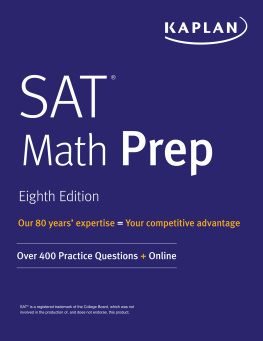SCORE A GOAL IN MATH!
Guess what? Lots of math is used in sports! How many points is a field goal? What percent of quarterback passes were intercepted? Even batting averages involve fractions and decimals. So get warmed up and ready to tackle some sports word problems, which include addition, multiplication, division, subtraction, fractions, and decimals. Learn some history and stats about your favorite athletes, too!
"Students often don't see the relevance of classroom math to their world. This series takes them into the exciting world of athletics, showing the direct relationship between the math the students are learning and various sports. Each book concludes with a fun chapter describing a competitive game, meet, or race in which the use of math enhances the excitement."
Carolyn Taylor, Series Math Consultant, Recipient of the Presidential Award for Excellence in Mathematics and Science Teaching
ABOUT THE AUTHOR
Stuart A.P. Murray is the author of more than forty books, a book editor, and a former journalist. He played soccer at Rutgers University and as a semi-pro, and has coached youth, high school, and college soccer. His latest fiction titles, Matty in the Goal and Todd Goes for the Goal, published by Enslow Publishers, Inc., are about youth soccer players.


Image Credit: 2012 Clipart.com
The goalie saves a penalty kick in the European Champions League final.
Soccer is the worlds most popular team sport. Most people in the world call it football. It got this name because it was played on foot instead of on horseback.
Early football was wild and rough and played by hundreds on each side. Players moved a ball across a field and could kick, punch, or carry it.
When the Pilgrims landed in America in 1620, they found that the local Wampanoag people played the same sport. The Pilgrims and Wampanoags soon were playing football on the beach with a deerskin ball. By the 1800s, Americans came to call it soccer.
In this book youll learn some soccer facts and history, and youll practice math, too. Knowing math makes playing or watching soccer even more exciting.
Nowadays, soccer is played by kicking and heading the ball. Only goalies may catch, throw, or punch the soccer ball.
Wherever soccer is played, scoring is the same: Put the ball in the other teams goal. There are plenty of soccer statistics (stats), and the most important is goals. But for a team to win the league, its points that count: a team gets 3 points for each win and 1 for each tie.
Strikers try to lead the league with the most goals scored. Goalies want to have the lowest goals allowed average. Theres more than just a league championship to play for, though.
There are competitions between teams from every country. And there are worldwide tournaments for mens and womens teams.
The greatest tournament is the World Cup, which is played every four years. The winning country can claim their national soccer team is the best in the world.

Image Credit: fstockfoto/Shutterstock.com Shutterstock.com
Spain won the 2010 World Cup.
There are two World Cups: one for women and one for men. The first mens World Cup played in the United States was in 1994. More than 3.5 million fans came to the games, breaking the record by more than 1 million. Millions more watched on television in every country. World Cup USA 94 was one of the greatest in history.

Image Credit: Wikimedia/John Mena
Mia Hamm, left, is the all-time U.S. womens team scoring leader with 158 goals.
In 1999, the Womens World Cup was held in the United States for the first time. The American womens soccer team has been one of the worlds best. In 1999 it won the Womens World Cup for the second time.
The American soccer tournaments were so successful that in 2003 the Womens World Cup was again held in the United States.

Image Credit: Wikimedia/Dipanker Dutta And Rafael Ramirez Lee/Shutterstock.com
Young men play muddy soccer in Kolkata, India. (Inset) Bernabu stadium in Madrid, Spain.
Around the world more than 250 million people play soccer. Their fields should be at least 100 yards long and 50 yards wide. But soccer fields come in many different sizes, depending on where they are located.
Crowded neighborhoods in many countries have only a small space for goals and a playing area. In the United States, high school campuses often have several full-size fields. And some European stadium fields are huge: 120 yards long and 75 yards wide!
Whatever the fields size, the object is to go for the goal!

Image Credit: Wikimedia/Ysangkok
The length and width of a soccer field for adults can vary, but the measurements around the goal area stay the same. The penalty box is 18 yards wide and 44 yards long.
Q: What is the perimeter of the penalty box?
A: The perimeter is the distance around the penalty box. This is found by adding the widths and the lengths of all four sides.
44 + 18 + 44 + 18 = 124 yds
Major League Soccer (MLS) is the leading professional soccer league in the United States and Canada. The MLS has 19 teams. The 10 largest stadiums are listed in the chart below.
Q: Which stadium has the largest playing field?
A: Real Salt Lake: 130 yds long by 90 yds wide
Q: How much older than the newest stadium is the oldest stadium?
A: Oldest: Portland, 1926; newest: Houston, 2012 Subtract the oldest from the newest.
2012 1926 = 86 years

The MLS was established in 1993. In 2011 it had 19 teams. Total attendance at all the games in 2011 was 5,460,000. There was an average of 17,872 fans per game.
Q: If every team drew exactly the same number of fans in 2011, what would be the average attendance per team?
A: Divide 5,460,000 by 19.
5,460,000 19 = 287,368 fans
In 2011, the Seattle Sounders led MLS in average game attendance: 38,496. The San Jose Earthquakes had the lowest: 11,858.
Q: How much higher average attendance than San Jose did Seattle have?
A: Subtract San Joses average game attendance from Seattles average.
38,496 11,858 = 26,638 more fans

Image Credit: 2012 Clipart.com

Image Credit: luoman/Photos.com

















